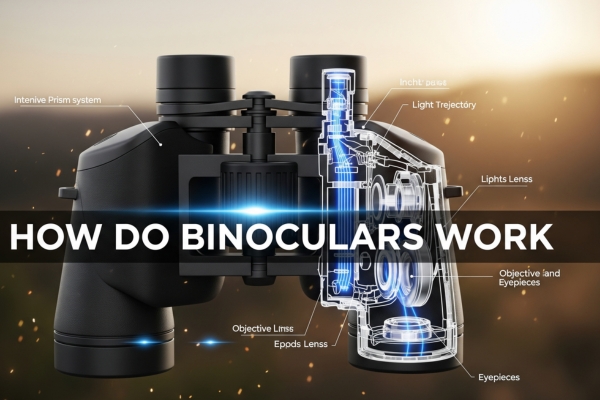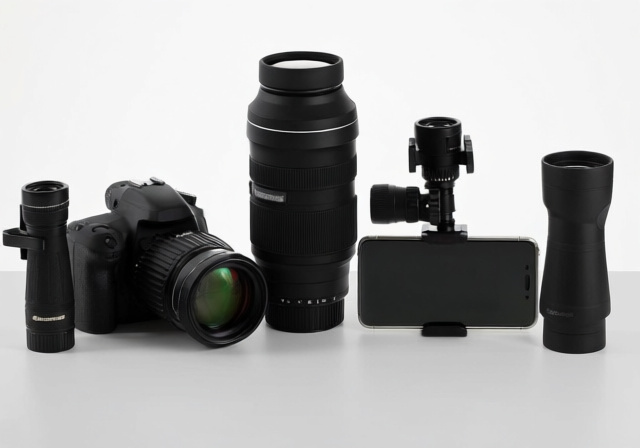



Ever wondered how those two tubes you look through can make distant objects appear so close? I’ve spent years studying optical devices, and binoculars remain one of the most elegant applications of physics in everyday use. Unlike a simple magnifying glass or even a telescope, binoculars create a three-dimensional view of the world while correcting the image orientation through an ingenious system of lenses and prisms.
The basic principle seems straightforward – gather light, magnify it, and deliver it to your eyes. But the actual physics involves multiple stages of light manipulation that would make Isaac Newton proud. When light from a distant object enters your binoculars, it undergoes a carefully orchestrated journey through objective lenses, prisms, and eyepieces before reaching your eyes as a magnified, correctly oriented image.
What makes binoculars particularly fascinating is how they solve a fundamental problem in optics. A simple telescope creates an upside-down image, which is fine for astronomy but terrible for bird watching or sports events. Binoculars use prisms to flip that image right-side up while maintaining the compact design we all recognize. This combination of practical engineering and optical physics creates an instrument that feels natural to use despite its complex inner workings.
Light behaves predictably when it passes through different materials, and binoculars exploit this behavior brilliantly. When light rays from a distant object hit the front lens of your binoculars, they’re traveling essentially parallel to each other. The objective lens, being convex (curved outward), bends these parallel rays inward through a process called refraction. This bending occurs because light changes speed when moving between air and glass.
The amount of bending depends on two factors: the curvature of the lens and the refractive index of the glass. Higher quality binoculars use glass with specific refractive properties to minimize chromatic aberration – that annoying color fringing you sometimes see around bright objects. The objective lens creates what we call a real image inside the binocular tube, but this image is inverted and reversed.
Here’s where the magic happens. That real image becomes the object for the eyepiece lens system. The eyepiece acts like a sophisticated magnifying glass, taking that small real image and creating a virtual image that appears much larger to your eye. The magnification you see listed on binoculars (like 8x or 10x) represents the ratio between the focal lengths of the objective and eyepiece lenses.
The objective lens is the unsung hero of any binocular system. Typically ranging from 20mm to 56mm in diameter (that second number in “8×42” specifications), this lens determines how much light your binoculars can gather. Larger objectives collect more light, making them better for low-light conditions, but they also make the binoculars heavier and bulkier. The quality of the glass and coatings on this lens directly impacts image brightness and clarity.
Between the objective lens and eyepiece sits the prism system – either Porro or roof prisms. Porro prisms, invented by Ignazio Porro in the 1850s, use two right-angle prisms per barrel to correct the image orientation. They create that classic wide-bodied binocular shape. Roof prisms, more complex but allowing for a straight-barrel design, use a series of reflections within specially shaped prisms to achieve the same image correction in less space.
The eyepiece isn’t just a single lens but typically contains three to six lens elements working together. These elements correct various optical aberrations and provide a comfortable viewing experience. Modern eyepieces often include aspherical elements – lenses with non-spherical surfaces that reduce distortion at the edges of your view. The eye relief, or distance you can hold your eye from the eyepiece while still seeing the full field of view, is crucial for glasses wearers.
Don’t overlook the focusing mechanism. Most binoculars use a central focusing wheel that moves the eyepieces simultaneously, allowing you to focus both barrels at once. Many also include a diopter adjustment on one eyepiece to compensate for differences between your eyes. This mechanical precision ensures that both optical paths remain perfectly aligned while allowing for quick focus adjustments.
Without prisms, binoculars would show you an upside-down and backwards world. The objective lens naturally creates an inverted image – it’s just how convex lenses work. In astronomical telescopes, this isn’t a problem since there’s no real “up” in space. But for terrestrial viewing, we need that image flipped back to match reality.
Porro prisms achieve this through total internal reflection. When light hits the angled surfaces of the prism at the correct angle, it bounces off like a perfect mirror without any loss of brightness. The first prism flips the image horizontally, and the second flips it vertically. The result? An image that matches what you’d see with the naked eye, just magnified. The offset design of Porro prism binoculars actually provides better depth perception than roof prism models because it increases the effective distance between the objective lenses.
Roof prisms are engineering marvels that accomplish the same image correction in a straight line. They use a combination of reflective surfaces arranged in a roof-like peak (hence the name) to redirect light multiple times within a compact space. The Schmidt-Pechan and Abbe-Koenig are two common roof prism designs, each with specific advantages. These prisms require extremely precise manufacturing and special phase-correction coatings to match the performance of simpler Porro prisms.
The choice between prism types affects more than just binocular shape. Porro prisms naturally provide slightly brighter images because they require fewer special coatings. Roof prisms need phase-correction coatings to prevent light wave interference that would otherwise reduce image quality. High-end roof prism binoculars with proper coatings can match Porro prism performance, but at a significantly higher manufacturing cost.
Our brains evolved to process images from two eyes simultaneously, creating depth perception through stereoscopic vision. Binoculars preserve and enhance this natural ability by providing each eye with a slightly different viewing angle of the same scene. This stereoscopic effect is why binoculars feel more immersive than monoculars or spotting scopes – your brain interprets the two images just as it would natural vision.
The interpupillary distance adjustment (IPD) on binoculars lets you match the instrument to your eye spacing. When properly adjusted, the two circular fields of view merge into one, and your brain seamlessly combines them. This isn’t just about comfort – proper IPD alignment ensures that both eyes are looking straight through the optical centers of their respective barrels, minimizing eye strain and maximizing image quality.
Binocular vision also provides practical advantages beyond depth perception. Using both eyes reduces eye fatigue during extended viewing sessions. Your brain averages out small imperfections or floaters in individual eyes, resulting in a cleaner perceived image. Studies have shown that binocular viewing can actually improve contrast detection by about 40% compared to monocular viewing, making it easier to spot wildlife or other subtle details.
That first number in binocular specifications tells you the magnification power. An 8x binocular makes objects appear eight times closer than they do to the naked eye. But higher isn’t always better. As magnification increases, the field of view narrows, image stability decreases, and the depth of field becomes shallower. Hand shake becomes more noticeable too – that’s why most handheld binoculars stay between 8x and 12x magnification.
Field of view (FOV) represents how wide an area you can see through the binoculars. It’s usually expressed as feet at 1,000 yards or degrees of arc. A typical 8×42 binocular might have a field of view of 330 feet at 1,000 yards, meaning you could see an area 330 feet wide if you were looking at something 1,000 yards away. Wide-angle binoculars sacrifice some edge sharpness for a broader view, while standard models prioritize edge-to-edge clarity.
The exit pupil, calculated by dividing the objective lens diameter by magnification, determines how bright the image appears. A 8×42 binocular has a 5.25mm exit pupil (42÷8=5.25). In bright daylight, your eye’s pupil contracts to about 2-3mm, so extra exit pupil size doesn’t help. But in dim conditions, when your pupil dilates to 5-7mm, a larger exit pupil delivers a noticeably brighter image. This is why 7×50 binoculars (7.1mm exit pupil) remain popular for marine and astronomical use.
Every time light passes through a glass surface, about 4-5% reflects back instead of transmitting through. With 10-14 glass surfaces in typical binoculars, you’d lose half your light without coatings. Modern anti-reflective coatings reduce these losses to less than 0.5% per surface, dramatically improving brightness and contrast.
Fully multi-coated optics apply multiple layers of anti-reflective compounds to every glass surface. These coatings are incredibly thin – often just a quarter wavelength of light – and must be applied with nanometer precision. Different coating materials target different wavelengths, which is why quality binocular lenses often show green, purple, or amber reflections. These colors indicate which wavelengths are being controlled to optimize transmission of the visible spectrum.
Beyond basic anti-reflective coatings, premium binoculars feature specialized treatments. Dielectric coatings on roof prism models increase light reflection to over 99%, matching the naturally high reflectivity of Porro prisms. Phase-correction coatings on roof prisms keep light waves in sync, preserving image contrast and resolution. External lens coatings might include hydrophobic treatments that repel water and oils, making the binoculars easier to clean and maintain.
Chromatic aberration, where different colors focus at slightly different points, creates color fringing around high-contrast edges. Binocular manufacturers combat this using ED (Extra-low Dispersion) or HD (High Density) glass in objective lenses. These special glasses bend all wavelengths of light more uniformly. Some high-end models use fluorite crystal lens elements, which virtually eliminate chromatic aberration but at significant cost.
Spherical aberration occurs because spherical lens surfaces don’t focus light from the edges the same as light from the center. Aspherical lens elements solve this by having a more complex surface profile that compensates for these differences. The manufacturing complexity of aspherical lenses explains why binoculars with edge-to-edge sharpness cost considerably more than those with soft edges.
Internal reflections and stray light can wash out images and reduce contrast. Manufacturers address this through internal baffling, blackened lens edges, and specially designed lens hoods. The interior of quality binoculars is painted with ultra-matte black paint that absorbs over 99% of stray light. Some models include sliding or built-in lens hoods that extend beyond the objective lenses to block oblique light rays.
Weight distribution and construction materials make a huge difference. Roof prism binoculars concentrate weight along the central axis, while Porro prisms spread it wider. Magnesium alloy bodies weigh less than aluminum ones. Internal focusing mechanisms (where lenses move inside rather than extending barrels) add weight but improve weather sealing.
Absolutely. Look for binoculars with at least 15mm of eye relief – the distance your eye can be from the eyepiece while seeing the full field of view. Most binoculars have fold-down or twist-up eyecups that allow glasses wearers to get their eyes close enough to the eyepieces. You might not need your glasses at all if the binoculars have sufficient diopter adjustment to correct for your vision.
Waterproof binoculars use O-ring seals and nitrogen or argon purging to prevent any moisture from entering. They can be submerged without damage. Weather-resistant models resist rain and splashes but aren’t fully sealed. The inert gas in waterproof models also prevents internal fogging when temperatures change rapidly.
Military and marine binoculars prioritize different features. Marine models typically use 7×50 specifications for maximum light gathering and a wide, stable view on moving boats. Military binoculars often include ranging reticles, compass systems, and infrared filtering. Both types emphasize ruggedness and reliability over compact size.
Image-stabilized binoculars use either electronic sensors and motors or a gyroscopic mechanism to counteract hand shake. Electronic models detect movement and shift internal lens elements to compensate. Gyroscopic versions use a spinning disk to maintain orientation. Both systems allow for higher magnifications than normally usable handheld, but add weight, complexity, and battery requirements.
Double vision (seeing two overlapping circles) usually indicates misaligned optics, called decollimation. This can happen from drops or impacts. While minor misalignment might be correctable by adjusting the prism mounting screws, severe cases require professional collimation using specialized equipment. Prevention through careful handling is much easier than repair.
Binoculars represent centuries of optical refinement packed into a portable package. From the objective lenses gathering light to the prisms correcting orientation and the eyepieces presenting a magnified view, every component works in harmony to extend our visual reach. Understanding how these instruments work helps us appreciate both the physics principles and engineering decisions behind their design.
The next time you pick up a pair of binoculars, take a moment to consider the journey light takes through them. Those photons travel from a distant object, get focused by precision-ground lenses, bounce through carefully aligned prisms, and finally reach your eyes as a bright, magnified image. It’s a testament to human ingenuity that we’ve made this complex process feel as natural as simply looking through two tubes.
Whether you’re watching wildlife, studying the stars, or catching the action at a sporting event, binoculars enhance our natural vision through applied physics. The principles haven’t changed much since their invention, but modern materials, coatings, and manufacturing precision have pushed performance to levels early inventors could only dream about. As optical technology continues advancing, who knows what enhancements future binoculars might bring to our view of the world.







